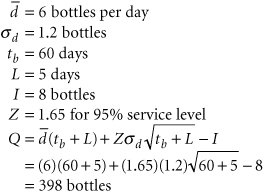Order Quantity for a Periodic Inventory System
| Previously we defined a continuous, or fixedorder quantity, inventory system as one in which the order quantity was constant and the time between orders varied. So far, this type of inventory system has been the primary focus of our discussion. The less common periodic , or fixedtime period , inventory system is one in which the time between orders is constant and the order size varies. A drugstore is one example of a business that sometimes uses a fixed-period inventory system. Drugstores stock a number of personal hygiene and health- related products, such as shampoo, toothpaste, soap, bandages, cough medicine, and aspirin. Normally, the vendors that provide these items to the store will make periodic visitsfor example, every few weeks or every monthand count the stock of inventory on hand for their products. If the inventory is exhausted or at some predetermined reorder point, a new order will be placed for an amount that will bring the inventory level back up to the desired level. The drugstore managers will generally not monitor the inventory level between vendor visits but instead rely on the vendor to take inventory at the time of the scheduled visit. A periodic inventory system uses variable order sizes at fixed time intervals . A limitation of this type of inventory system is that inventory can be exhausted early in the time period between visits, resulting in a stockout that will not be remedied until the next scheduled order. Alternatively, in a fixedorder quantity system, when inventory reaches a reorder point, an order is made that minimizes the time during which a stockout might exist. As a result of this drawback, a larger safety stock is normally required for the fixed-interval system. A periodic inventory system normally requires a larger safety stock . Order Quantity with Variable DemandIf the demand rate and lead time are constant, then the fixed-period model will have a fixed order quantity that will be made at specified time intervals, which is the same as the fixed quantity (EOQ) model under similar conditions. However, as we have already explained, the fixed-period model reacts significantly differently from the fixedorder quantity model when demand is a variable. The order size for a fixed-period model, given variable daily demand that is normally distributed, is determined by the following formula: where
The first term in the preceding formula, d ( t b + L ), is the average demand during the order cycle time plus the lead time. It reflects the amount of inventory that will be needed to protect against shortages during the entire time from this order to the next and the lead time, until the order is received. The second term, The Corner Drug Store stocks a popular brand of sunscreen. The average demand for the sunscreen is 6 bottles per day, with a standard deviation of 1.2 bottles. A vendor for the sunscreen producer checks the drugstore stock every 60 days, and during a particular visit the drugstore had 8 bottles in stock. The lead time to receive an order is 5 days. The order size for this order period that will enable the drugstore to maintain a 95% service level is computed as follows : Determining the Order Quantity for the Fixed-Period Model with ExcelExhibit 16.7 shows an Excel spreadsheet set up to compute the order quantity for the fixed-period model with variable demand for our Corner Drug Store example. Notice that the formula for the order quantity in cell D10 is shown on the formula bar at the top of the spreadsheet. Exhibit 16.7. |
EAN: 2147483647
Pages: 358

